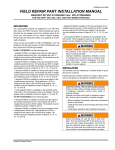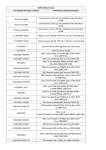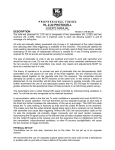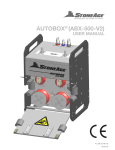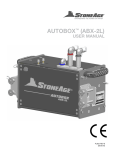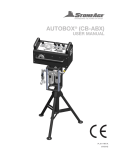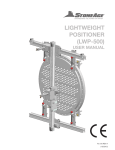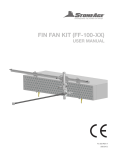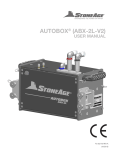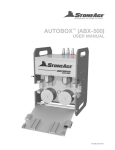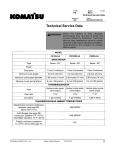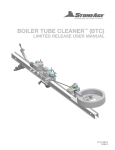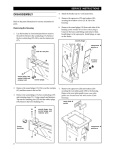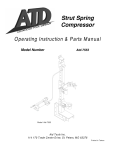Download BADGER 4” 40K - StoneAge Inc
Transcript
BADGER 4” 40K SELF-ROTARY SWIVEL (BA-H6) USER MANUAL PL-600 (09/2014) OVERVIEW DESCRIPTION: The Badger™ Rotary Waterblast Nozzle was designed for waterblast cleaning of pipes as small as 4 inch with elbows. The BA-H6 has a 3/8 high pressure female inlet connection and a maximum operating pressure of 43,500 psi (3000 bar). A viscous fluid is used to control rotation speed in the range of 200 to 500 rpm. The Badger™ heads have five S6 ports; one at 15 degrees, two at 100 degrees, and two at 125 degrees Engraved on each head is R14 or R24; this number is the offset of the head that makes it rotate. The flow range for each head is given in the table; nozzle sizes must be selected to fit within this flow range. If the flow is less than the range shown, the tool will not rotate; if it is more than the range maximum, the tool will rotate too fast and wear out the seals and bearings prematurely. FLOW RANGE PRESS. PSI R50 R35 R25 43,500 (3000 BAR) 4.5-7 GPM 7-9.5 GPM 9.5-12 GPM The Badger should begin to slowly rotate. Once operating pressure is reached, feed the tool into the pipe to begin the cleaning job. Allow the jets time to do their work by feeding the hose out at a controlled rate. The StoneAge ABX-500 Hose Control Device can be used to achieve consistant feed rates for pipe cleaning. When the work is complete and the tool is isconnected from the hose, blow out all water to prolong the life of the tool. A small amount of oil can be blown into the tool as well as an added measure to maximize tool life. WARNING Operations with this equipment can be potentially hazardous. Caution must be exercised prior to and during machine and water jet tool use. Please read and follow all of these instructions, in addition to the guidelines in the WJTA Recommended Practices handbook, available online at www.wjta.org. Deviating from safety instructions and recommended practices can lead to severe injury and/or death. FIGURE 1 OPERATION: The first step is to determine the jet sizes. Jet thrust is used to pull the tool through the pipe. An estimate of the amount of pulling force required is useful and depends on the number of elbows and any vertical climbs that must be made. On a horizontal run with no elbows, roughly 1 pound of pull is required for every ten feet. When climbing vertically, the pulling force must equal the weight of the tool and the hose. Typically, larger jet sizes using 40-60% of the total flow are used in the back 125° ports. As little as 10% of the total flow is given to the front jet, because it pushes the wrong direction and is only used to open up blockages. The remaining flow goes to the 100° ports, which do help pull as well, but are mor fuctional for pipe cleaning. Nozzles selected should be matched pairs, except the front jet. When installing nozzles, we recommend using Blue Goop® antisieze. 1-1/2 times pipe ID Rigid Stinger WARNING Because of the short length of the Badger, the tool can turn around in large pipes and come back at the operator at a high rate of speed. If cleaning larger pipes, a rigid “stinger” should be used between the hose and the tool. It is recommended that the rigid length of the tool including hose end is 1-1/2 times the inside diameter of the pipe being cleaned (see Figure 1). IMPROPER USE: Badger will turn around in large diameter pipe VERY DANGEROUS! Make sure there is an operator controlled dump in the system, operated by the person closest to the cleaning job. Flush out the high pressure hoses before connecting the Badger. It is recommended that the hose be marked a few feet from the end with a piece of tape so the operator knows when to stop when retracting the tool. Position the tool in the pipe opening. Close the dump and slowly bring up to pressure the first time to make sure no nozzles are plugged and the jet thrust is correct. 2 866-795-1586 • WWW.STONEAGETOOLS.COM PROPER USE: Badger with rigid “stinger” to prevent turnaround, still able to pass thru elbows. OPERATION TROUBLESHOOTING: High-pressure seal leak: The high pressure seal may leak initially at lower pressures, but should pop closed as pressure is increased. A continuous leak at operating pressure from the weep holes indicates the need to replace the HP Seal and Seat. HP Seals wearing out too quickly can be an indication that the HP Seat is installed upside-down, or the tool is rotating too fast (see below for causes). If the tool is leaking, but not over rotating, the BA 600-H6 Seal Kit is required. Weep Holes Tool will not rotate: • Check the nozzles for plugging or wear (nozzles have to be removed to check for obstructions). • Check that the nozzle sizes are correct for the desired flow and that the desired flow matches the head flow range. • Check that the nozzle sizes are installed in a balanced configuration. • If the tool feels rough when manually rotating the head, this indicates internal damage and BA 610-H6 Overhaul Kit will be required. Tool rotates too fast: A significant increase in rotation speed means that the speed control mechanism in the tool has lost functionality. This can be a result of viscous fluid loss or fluid contamination. Operation of the tool in this state can cause damage to other components and accelerated wear of the high pressure seal. If this occurs, the first step is to flush the tool with new viscous fluid as shown in Figure 2. AVAILABLE MAINTENANCE KITS: BA 600-H6 Seal Kit Includes parts needed for one seal change A 610-H6 Overhaul Kit Includes parts needed for complete tool rebuild; i.e. o-rings, bearings and shaft seals BA 612-H6 Tool Kit Includes tools to aid in tool assembly 866-795-1586 • WWW.STONEAGETOOLS.COM 3 MAINTENANCE BA-H6 Part Detail: BA-H6 PART DETAIL: MJ 014 Wave Spring (1) BA 401 Shaft (1) BA 402 Nut (1) BC 511 Carbide Seat (1) BA 424 Spring (1) BA 420 Seal Holder (1) BA 430 Wear Ring (1) BJ 008 O-ring (1) BA 409 Bearing (1) BJ 026 (2) Port Screw OS-6 XXX (5) Sapphire Nozzle BA 007 Shaft Seal WGR 007 Bearing (1) BA 412-O HP Seal Assy (1) BA 425 Compression Nut (1) BA 407 Shaft Seal (1) BA 426 Seat Face (1) BC 040 O-ring (1) BC 031 Backup Ring (1) BA 440-RXX Head (1) OS-4 002 Plug (1) Figure 3: Tool Parts List VISCOUS FLUID FLUSH INSTRUCTIONS: 1.Remove the Port Screws (BJ 026) in the Nut (BA 402) and Head (BA 440-RXX) (see Figure 2). BJ 026 Port Screw (in Nut) 2.Fill the Syringe (BC 410) with viscous fluid by removing the end near the handle, pulling out the plunger, and pouring the Viscous Fluid (BJ 048-F) in to fill the Syringe Body. With plunger re-installed, purge air out of Syringe hose. 3.Thread the syringe end into the port in the Head, and squeeze fresh Viscous Fluid in until clean Viscous Fluid comes out the port in the Nut. Hold the tool so the port in the Nut is the highest point. If air bubbles come out of the port on the nut, keep flushing new fluid until air bubbles stop. 4. Install Port Screw into Nut first. Remove the Syringe and install the Port Screw in the Head. 5.If tool rotation speed does not slow down to the normal range, a BA 610-H6 Overhaul Kit may be required. See Disassembly and Reassembly instructions on the next page. BA 402 Nut (1) BJ 026 Port Screw (In Head) BC 410 Syringe BA 440-RXX Head (1) Figure 2: Viscous Fluid Flush Figure 2: Viscous Fluid Flush 4 866-795-1586 • WWW.STONEAGETOOLS.COM DISASSEMBLY DISASSEMBLY: 1. Place tool in a vice in orientation shown in Figure 4. 2. Remove Port Screw (BJ 026) from Nut (BA 402). 3. Unscrew Nut from Head (BA 440-RXX). Remove Nut and Wear Ring (BA 430). BJ 026 Port Screw BA 402 Nut BA 430 Wear Ring 6. Use 3/8” allen key or StoneAge tool BA 483 to remove Compression Nut (BA 425) and set aside. 7. Use a small pick to remove Seal Holder (BA 420) followed by the Carbide Seat (BC 511), HP Seal Assy (BA 412-O), and Spring (BA 424). 8. Wave Spring (MJ 014) can be removed next. If Wave Spring appears flat, replace. BA 425 Compression Nut BC 511 Carbide Seat MJ 014 Wave Spring BA 424 Spring BA 481 Bearing Removal Tool BA 401 Shaft WGR 007 Bearing BA 440-RXX Head Figure 4: for Steps 1-3 Figure 4: For Steps 1-3 BA 420 Seal Holder BA 412-O HP Seal Assy Figure 7: for Steps 6-9 4. Inspect Shaft Seal (BA 007) and remove from Nut if damaged (see Figure 5). 9. Use the Bearing Removal Tool (BA 481) to remove the Bearing (WGR 007). 10.Remove Seat Face (BA 426) from head with 5/16” nut driver or StoneAge tool BA 482. BA 007 Shaft Seal 11.Inspect Backup Ring (BC 031) and O-ring (BC 040) and remove if any damage is suspected. BA 426 Seat Face BA 402 Nut Figure 5: for Step 4 Figure 5: For Step 4 5. Remove Shaft (BA 401) from Head. Pliers or vice grips may be nessesary to grab the Shaft as viscous fluid and tool seals can cause a suction force (see Figure 6). BC 031 Backup Ring BC 040 O-ring BA 407 Shaft Seal BA 409 Bearing BJ 008 O-ring BA 401 Shaft BA 440-RXX Head Figure 8:10-14 For Steps Figure 8: for Steps 10-14 12.Inspect Shaft Seal (BA 407). If damaged, remove the Seal from head. BA 440-RXX Head Figure 6: for Step 5 Figure 6: For Step 5 13.Remove Bearing (BA 409) from inside the Head. 14.Inspect O-ring (BJ 008). If damaged, remove from Head. 15.Let old Viscous Fluid drain from all parts. 866-795-1586 • WWW.STONEAGETOOLS.COM 5 ASSEMBLY ASSEMBLY: 1. Install O-ring (BJ 008) over threads on Head (BA 440-RXX) and into groove. 8. Thread Compression Nut (BA 426) into Shaft. Tighten to 20 ft*lbs. Apply anti-sieze to threads prior to installation. 2. Install Bearing (BA 409) on boss inside of Head (may require light press). 9. Slide Wave Sping (MJ 014) in open end of Shaft down to inner shoulder (see Figure 11). 3. Press Shaft Seal (BA 407) into Head in orientation shown in Figure 9. Grease inner lip. BA 426 Compression Nut 4. Install Backup Ring (BC 031) and O-ring (BC 040) into groove on the Seat Face (BA 426) in orientation shown in Figure 10. Grease around both rings. Apply anti-sieze on threads prior to installation. Thread the Seat Face into Head and tighten to approximately 10 ft*lbs. BA 424 Spring MJ 014 Wave Spring BA 426 Seat Face BC 031 Backup Ring BC 040 O-ring BA 407 Shaft Seal BA 401 Shaft Open Side Facing Up WGR 007 Bearing Figure Steps 5-95-9 Figure11: 11:For For Steps BA 409 Bearing BJ 008 O-ring BA 426 Seat Face BA 426 Compression Nut BA 424 Spring Open Side BA 440-RXX Head Facing Up BA 420 Seal Holder MJ 014 Wave Spring Concave side Figure 9: For Steps 1-4 Groove Facing Down! towards O-ring Figure 10: Seat face and O-rings Detail BC 511 Carbide Seat BA 401 Shaft WGR 007 Bearing Chamfer towards high pressure seal! Figure 11: For Steps 5-9 Concave side towards O-ring ps 1-4 Figure Seat and Detail Figure 10: Seat10: Face andface O-rings BA 412-O HP Seal Assy O-rings Detail 5. Press Bearing (WGR 007) onto Shaft (BA 401). 6. Install the high pressure seal stack into the shaft. Start with the Spring (BA 424), followed by the HP Seal Assy (BA 412-O), then the Seal Holder (BA 420). See Figure 12 for orientation of goove in Seal Holder and direction of HP Seal Assy. Apply grease to each component when installing to hold them in the shaft. 7. Install Carbide Seat (BC 511) into Seal Holder. Note orientation of chamfer in Figure 12. Use grease to hold the Carbide Seat in place. 6 866-795-1586 • WWW.STONEAGETOOLS.COM Figure 12: Seat and Seal Detail Figure 12: Seat and Seal Detail ASSEMBLY 10.Detail 10. Place Head in a vice as shown in Figure 13. Fill inside of Head with Viscous Fluid (BJ 048-F) until it is flush with the top of the Bearing (BA 409) inside the Head. Rock side to side and make sure no air is trapped under Bearing in Head. 11.Slide Shaft into the Head. Push down firmly until Viscous Fluid is forced out of holes in the back of the Shaft. 12.Rotate Shaft clockwise vigorously. Alternate between forcing Viscous Fluid down the holes in the back of the Shaft and rotating Shaft. Repeat until Shaft rotation becomes stiff and no more air bubbles appear when new fluid is forced in. Port Screw (BJ 026) can also be removed from Head and Syringe (BC 410) can be used to force Viscous Fluid in from the bottom to purge air out of tool. 14.Slide Wear Ring (BA 430) over Head with inner lip down (see Figure 15). 15.Put layer of Viscous Fluid on top of Bearing (WGR 007). 16.Put anti-sieze on threads of Head. Thread Nut onto Head (Port Screw not installed). Tighten Nut to 40 ft*lbs and let excess Viscous Fluid bleed out of Port Screw hole. 17.Install Port Screw into threaded port on Nut. BJ 026 Port Screw BA 402 Nut BA 430 Wear Ring BA 401 SHaft Inner Lip Facing Down BA 440-RXX Head Figure Figure15: 15:For ForSteps Steps14-17 14-17 BJ 026 Port Screw BA 440-RXX Head Note: Only use Viscous Fluid filled sealed bearings from StoneAge when performing a complete tool overhaul! Figure 13: For Steps 10-12 Figure 13: For Steps 10-12 13.13. Press Shaft Seal (BA 007) into Nut (BA 402). Grease inner lip of seal (see Figure 14). BA 007 Shaft Seal Spring lip facing upward BA 402 Nut Figure 14: Step Figure 14: For For Steps 13 13 866-795-1586 • WWW.STONEAGETOOLS.COM 7 1-866-795-1586 • www.STONEAGETOOLS.com © 2014 StoneAge, Inc. All Rights Reserved








